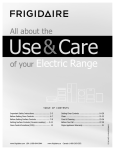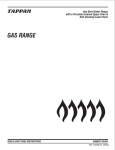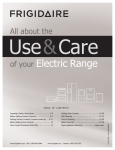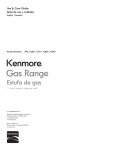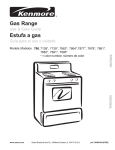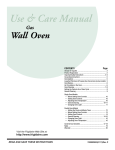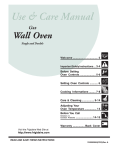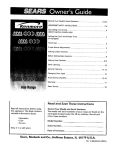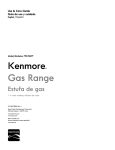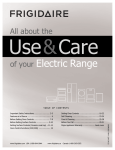Download Kenmore 4.2 cu. ft. Electric Range - White Owner's Manual
Transcript
Use & Care Guide Guía de uso y cuidada English / Español Model/Modelos: 790. 9001*, 9011*, 9083*, 9300*, 9302* Kenmore Electric Range ® Estufa eléctrica * = color number, código de color P/N 316902003 Rev E Sears Brands Management Corporation Hoffman Estates, IL 60179 U.S.A. www.kenmore.com www.sears.com Table of Contents Appliance Warranty ............................................................................. 2 Important Safety Instructions ......................................................... 3-6 Product Record/Serial Plate Location ............................................... 6 Before Setting Oven Controls .............................................................. 7 Removing, replacing and arranging oven racks .......................... 7 Before Setting Surface Controls ...................................................... 8-9 Using proper cookware .................................................................... 8 Cookware material types ................................................................. 9 Home canning .................................................................................... 9 Setting Surface Controls ...................................................................... 10 Surface element settings ................................................................. 10 Oven Control Features .......................................................................... 11 Setting Oven Controls ..................................................................... 11-14 Setting Clock ...................................................................................... 11 Changing oven temperature display (F° or C°) ........................... 11 Setting Timer ..................................................................................... 12 Setting Bake ...................................................................................... 12 Broil ..................................................................................................... 13 Adjusting Oven Temperature ......................................................... 14 Care & Cleaning .............................................................................. 15-19 Cleaning recommendation table ................................................... 15 General cleaning .............................................................................. 16 Surface elements and drip bowls .................................................. 17 Removing and replacing lift-off oven door ................................. 19 Before You Call - Solutions to common problems .................... 20-21 Master Protection Agreement ............................................................ 23 Sears Service ......................................................................... back cover Kenmore Limited Warranty When installed, operated and maintained according to all instructions supplied with the product, if this appliance fails due to a defect in material and workmanship within one year from the date of purchase, call 1-800-4-MY-HOME® to arrange for free repair. This warranty applies for only 90 days from the date of purchase if this appliance is ever used for other than private family purposes. This warranty covers only defects in material and workmanship. Sears will NOT pay for: 1. Cracks in a ceramic glass cooktop that are not a result of thermal shock. 2. Stains and scratches on a ceramic glass cooktop resulting from failure to maintain it properly according to all instructions supplied with the product. 3. Expendable items that can wear out from normal use, including but not limited to filters, belts, light bulbs, and bags. 4. A service technician to instruct the user in correct product installation, operation or maintenance. 5. A service technician to clean or maintain this product. 6. Damage to or failure of this product if it is not installed, operated or maintained according to all instructions supplied with the product. 7. Damage to or failure of this product resulting from accident, abuse, misuse or use for other than its intended purpose. 8. Damage to or failure of this product caused by the use of detergents, cleaners, chemicals or utensils other than those recommended in all instructions supplied with the product. 9. Damage to or failure of parts or systems resulting from unauthorized modifications made to this product. Disclaimer of implied warranties; limitation of remedies Customer’s sole and exclusive remedy under this limited warranty shall be product repair as provided herein. Implied warranties, including warranties of merchantability or fitness for a particular purpose, are limited to one year or the shortest period allowed by law. Sears shall not be liable for incidental or consequential damages. Some states and provinces do not allow the exclusion or limitation of incidental or consequential damages, or limitation on the duration of implied warranties of merchantability or fitness, so these exclusions or limitations may not apply to you. This warranty applies only while this appliance is used in the United States. This warranty gives you specific legal rights, and you may also have other rights which vary from state to state. Sears Brands Management Corporation, Hoffman Estates, IL 60179 U.S.A. All rights reserved. Printed in the USA. 2 Important Safety Instructions Read all instructions before using this appliance. This manual contains important safety symbols and instructions. Please pay attention to these symbols and follow all instructions given. Tip Over Hazard • A child or adult can tip the range and be killed. • Verify the anti-tip device has been installed to floor or wall. Definitions This is the safety alert symbol. It is used to alert you to potential personal injury hazards. Obey all safety messages that follow this symbol to avoid possible injury or death. • Ensure the anti-tip device is re-engaged when the range is moved to floor or wall. • Do not operate the range without the anti-tip device in place and engaged. • Failure to follow these instructions can result in death or serious burns to children and adults. Do not attempt to install or operate your appliance until you have read the safety precautions in this manual. Safety items throughout this manual are labeled with a WARNING or CAUTION statement based on the risk type. Range leveling leg - indicates a potentially hazardous situation which, if not avoided, may result in death or serious injury. - indicates a potentially hazardous situation which, if not avoided, may result in minor or moderate injury. Anti-Tip bracket To check if the anti-tip bracket is installed properly, use both arms and grasp the rear edge of range back. Carefully attempt to tilt range forward. When properly installed, the range should not tilt forward. • Remove all tape and packaging before using the range. Destroy the carton and plastic bags after unpacking the range. Never allow children to play with packaging material. Refer to the anti-tip bracket installation instructions supplied with your range for proper installation. • Remove the oven door from any unused range if it is to be stored or discarded. • Proper installation—Be sure your appliance is properly installed and grounded by a qualified technician in accordance with the National Electrical Code ANSI/ NFPA No. 70 latest edition and local electrical code requirements. Install only per installation instructions provided in the literature package for this range. • Do not attempt to operate the range during a power failure. If the power fails, always turn off the range. If the range is not turned off and the power resumes, the range will begin to operate again. Once the power resumes, reset the clock and oven function. • User servicing—Do not repair or replace any part of the appliance unless specifically recommended in the manuals. All other servicing should be done only by a qualified technician, This may reduce the risk of personal injury and damage to the range. Stepping, leaning or sitting on the door or drawers of a range can result in serious injuries and also cause damage to the appliance. DO NOT allow children to climb or play around the range. The weight of a child on an open oven door may cause the range to tip, resulting in serious burns or other injury. Ask your dealer to recommend a qualified technician and an authorized repair service. Know how to disconnect the power to the range at the circuit breaker or fuse box in case of an emergency. Storage in or on appliance — flammable materials should not be stored in an oven, near surface units or in the storage drawer, warmer drawer or lower oven. This includes paper, plastic and cloth items, such as cookbooks, plasticware and towels, as well as flammable liquids. Do not store explosives, such as aerosol cans, on or near the range. • Never modify or alter the construction of a range by removing the leveling legs, panels, wire covers, anti-tip brackets/screws, or any other part of the range. Save these instructions for future reference. 3 Important Safety Instructions NEVER cover any slots, holes or passages in the oven bottom or cover an entire oven rack with materials such as aluminum foil. Aluminum foil linings may trap heat, causing a fire hazard. Do not heat unopened food containers — buildup of pressure may cause container to burst and result in injury. Important Safety Notice The California Safe Drinking Water and Toxic Enforcement Act requires the Governor of California to publish a list of substances known to the state to cause cancer, birth defects or other reproductive harm, and requires businesses to warn customers of potential exposure to such substances. DO NOT LEAVE CHILDREN ALONE — children should not be left alone or unattended in the area where appliance is in use. They should never be allowed to sit or stand on any part of the appliance, including the storage drawer, lower broiler drawer, warmer drawer or lower double oven. IMPORTANT INSTRUCTIONS FOR USING YOUR OVEN Do not store items of interest to children in the cabinets above a range or on the backguard of the range. Children climbing on the range to reach items could be seriously injured. Protective Liners — DO NOT USE ALUMINUM FOIL to line the oven bottom. Only use aluminum foil as recommended in this manual. Improper installation of these liners may result in risk of electric shock, or fire. DO NOT TOUCH SURFACE HEATING UNITS, OR SURFACE COOKING ELEMENTS, AREAS NEAR THESE SURFACE HEATING UNITS, OR INTERIOR SURFACE OF THE OVEN. Both surface heating and oven heating elements may be hot even though they are dark in color. Areas near surface cooking units may become hot enough to cause burns. During and after use, do not touch, or let clothing or other flammable materials touch these areas until they have had sufficient time to cool. Among these areas are the cook top, surfaces facing the cook top, the oven vent openings and surfaces near these openings, oven door and oven door window. • Use care when opening oven door, warmer drawer or lower oven door — Stand to the side of the range when opening the door of a hot oven. Let hot air or steam escape before you remove or replace food in the oven. • Keep oven vent ducts unobstructed. The oven vent is located below the backguard. Touching the surfaces in this area when the oven is operating may cause severe burns. Also, do not place plastic or heat-sensitive items on or near the oven vent. These items could melt or ignite. Wear proper apparel — loose-fitting or hanging garments should never be worn while using the appliance. Do not let clothing or other flammable materials contact hot surfaces. • Placement of interior oven racks. Always place oven racks in desired location while oven is cool. If rack must be moved while oven is hot use extreme caution. Use potholders and grasp the rack with both hands to reposition. Do not let potholders contact the hot heating elements in the oven. Remove all utensils from the rack before moving. DO NOT USE WATER OR FLOUR on grease fires — smother the fire with a pan lid, or use baking soda, a dry chemical or foam-type extinguisher. When heating fat or grease, watch it closely. Fat or grease may catch fire if allowed to become too hot. • Do not use the broiler pan without its insert. The broiler pan and its insert allow dripping fat to drain and be kept away from the high heat of the broiler. Use dry potholders — moist or damp potholders on hot surfaces may result in burns from steam. Do not let potholders touch hot heating elements. Do not use a towel or other bulky cloth instead of a potholder. • Do not cover the broiler insert with aluminum foil. Exposed fat and grease could ignite. Save these instructions for future reference. 4 Important Safety Instructions IMPORTANT INSTRUCTIONS FOR USING YOUR COOKTOP COIL COOK TOP MODELS Protective liners — Do not use aluminum foil to line surface unit drip bowls, or reflector pans. Only use aluminum foil as recommended in this manual. Improper installation of these liners may result in risk of electric shock, or fire. • Know which knob controls each surface heating unit. Place a pan of food on the surface element unit before turning it on, and turn the element off before removing the pan. • Make sure reflector pans or drip bowls are in place — Absence of these pans or bowls during cooking may subject wiring or components underneath to damage. • Use proper pan size — This appliance is equipped with one or more surface units of different sizes. Select utensils having flat bottoms large enough to cover the surface unit heating element. The use of undersized utensils will expose a portion of the heating element to direct contact and may result in ignition of clothing. Proper relationship of utensil to element will also improve efficiency. • Utensil handles should be turned inward and not extend over adjacent surface elements — To reduce the risk of burns, ignition of flammable materials, and spillage due to unintentional contact with the utensil, the handle of the utensil should be positioned so that it is turned inward, and does not extend over adjacent surface units. • Never leave surface elements unattended at high heat settings — Boilovers cause smoking and greasy spillovers that may ignite, or a pan that has boiled dry may melt. • Glazed cooking utensils — Only certain types of glass, glass/ceramic, ceramic, earthenware, or other glazed utensils are suitable for cook top service without breaking due to the sudden change in temperature. Check the manufacturer’s recommendations for cook top use. • When flaming foods under a ventilating hood, turn the fan on. Save these instructions for future reference. 5 Important Safety Instructions IMPORTANT INSTRUCTIONS FOR CLEANING YOUR RANGE Before manually cleaning any part of the range, be sure all controls are turned OFF and the range is COOL. The range may be hot and can cause burns. • Clean the range regularly to keep all parts free of grease that could catch fire. Pay particular attention to the area around each surface element. Do not allow grease to accumulate. • Kitchen cleaners and aerosols — Always follow the manufacturer’s recommended directions for use. Be aware that excess residue from cleaners and aerosols may ignite causing damage and injury. • Clean ventilating hoods frequently — Grease should not be allowed to accumulate on the hood or filter. Follow the manufacturer’s instructions for cleaning hoods. Product Record Serial Plate Location In this space below, record the date of purchase, model and serial number of your product. You will find the model and serial number printed on an identification plate. See bottom of this page for serial plate location. 790. Model No. _____________________________________ Serial No. _____________________________________ To locate the serial plate open the storage drawer. The serial plate is attached to the lower right oven frame. Date of Purchase ________________________________ Save sales receipt for future reference. Save these instructions for future reference. 6 Before Setting Oven Controls Oven vent location Types of oven racks The oven vent is located under the left rear surface element (See Fig. 1). When the oven is on, warm air passes through this vent. This venting is necessary for proper air circulation in the oven and good baking results. Do not block oven vent. flat handle oven rack flat oven rack oven vent offset oven rack Fig. 1 Removing, replacing and arranging racks The flat oven rack or flat handle oven rack (on some models) may be used for most cooking needs. Always use pot holders or oven mitts when using the oven. When cooking, the oven interior, exterior, oven racks and cooktop will become very hot which can cause burns The offset oven rack (on some models) will place the base of the rack about 1/2 of a rack position lower than a flat oven rack. This feature provides several additional possible oven rack positions. Arranging - always arrange the oven racks when the oven is cool (prior to operating the oven). Air circulation in the oven For best baking results allow 2-4" (5-10 cm) around the cookware for proper air circulation and be sure pans and cookware do not touch each other, the oven door, sides or back of the oven cavity. Hot air must be able to circulate around the pans and cookware in the oven for even heat to reach around the food. To remove - pull the rack forward until it stops. Lift up front of rack and slide out. To replace - fit the rack onto the guides on the oven walls. Tilt the front of the rack upward and slide the rack back into place. Fig. 2 Recommended oven rack positions by food type: (Refer to Fig. 2 for oven rack positions) Food type Position Broiling Cookies, cakes, pies, biscuits & muffins Frozen pies, angel food cake, yeast, bread and casseroles Small cuts of meat or poultry Turkey, roast or ham See broil 2 or 3 1 or 2 1 or 2 1 7 Before Setting Surface Controls About the surface elements Using proper cookware The element temperature rises gradually and evenly. As the temperature rises, the element will glow red. The size and type of cookware used will influence the surface element power level setting needed for best cooking results. Be sure to follow the recommendations for using proper cookware as illustrated in both Figs. 1 & 2. For efficient cooking, turn OFF the surface element just before cooking is complete. This will allow residual heat to complete the cooking process. Surface elements may appear to have cooled after they have been turned off. The surface element may still be hot and burns may occur if the surface element is touched before it has cooled sufficiently. Fig. 1 Do not place plastic items such as salt and pepper shakers, spoon holders or plastic wrappings on top of the range when it is in use. These items could melt or ignite. Potholders, towels or wooden spoons could catch fire if placed too close to the surface elements. Check for flatness by rotating a ruler across the bottom of the cookware (See Fig. 1). Cookware should have flat bottoms that make good contact with the entire surface heating element (See Fig. 2). Do not use aluminum foil to line surface unit drip bowls, or reflector pans. Only use aluminum foil as recommended in this manual. Improper installation of these liners may result in risk of electric shock, or fire. Do not place aluminum foil or ANY material that could melt on the surface elements. Make sure reflector pans or drip bowls are in place — Absence of these pans or bowls during cooking may subject wiring or components underneath to damage. • Flat bottom and straight sides. • Tight fitting lids. • Weight of handle does not tilt pan. Pan is well balanced. • Pan sizes match the amount of food to be prepared and the size of the surface element. • Made of material that conducts heat well. • Easy to clean. • Always match pot diameter to surface element size. Element On indicator lights The ELEMENT ON indicator lights are marked on the control panel and will glow when a surface cooking element is turned ON. A quick glance at these indicator lights after cooking is an easy check to be sure ALL surface controls are turned OFF. 8 • Curved and warped pans. • Cookware larger than surface element on cooktop by more than one-half inch or 12mm. • Heavy handle tilts pan. • Pan is smaller than the surface element on cooktop. Fig. 2 Before Setting Surface Controls Cookware material types Home Canning The cookware material determines how evenly and quickly heat is transferred from the surface element to the pan bottom. The most popular materials available are: Be sure to read and observe all the following points when home canning with your appliance. Check with the USDA (United States Department of Agriculture) website and be sure to read all the information they have available as well as follow their recommendations for home canning procedures. Aluminum - Excellent heat conductor. Some types of food will cause it to darken (Anodized aluminum cookware resists staining & pitting). • Use only quality flat bottom canners when home canning. Use a straight-edge to check canner bottom. Copper - Excellent heat conductor but discolors easily. Stainless - Slow heat conductor with uneven cooking results. Is durable, easy to clean and resists staining. • Use only a completely flat bottom canner with no ridges that radiate from the bottom center when home canning using a ceramic cooktop. Cast Iron - A slow heat conductor however will retain heat very well. Cooks evenly once cooking temperature is reached. • Make sure the diameter of the canner does not exceed 1 inch beyond the surface element markings or burner. It is recommended to use smaller diameter canners on electric coil and ceramic glass cooktops. Porcelain-enamel on metal - Heating characteristics will vary depending on base material. • Start with hot tap water to bring water to boil more quickly. Glass - Slow heat conductor. • Use the highest heat seating when first bringing the water to a boil. Once boiling is achieved, reduce heat to lowest possible setting to maintain that boil. • NEVER place or straddle a cooking utensil over 2 different surface cooking areas at the same time. This will cause uneven heating results and may cause the ceramic cooktop to fracture. 9 Setting Surface Controls Surface element settings The size and type of utensil used, and the amount and type of food being cooked will influence the surface element power level setting needed for best cooking results. The suggested settings found in Fig. 1 below are based when cooking with medium-weight aluminum pans with lids. Settings may vary when using other types of pans. Suggested settings for surface elements Settings Type of cooking High (HI - 9) Start most foods, bring water to a boil, pan broiling Medium high (7 - 8) Continue a rapid boil, fry, deep fat fry Medium (5 - 6) Maintain a slow boil, thicken sauces and gravies or steam vegetables Medium Low (2 - 4) Keep foods cooking, poach, stew Low (LO - 1) Keep warm, melt, simmer Fig. 2 To operate the surface element: 1. Place correctly sized cookware on surface element. 2. Push in and turn the surface control knob in either direction to the desired setting (See Fig. 2). 3. When cooking is complete, turn the surface element OFF before removing the cookware. Important notes: • The surface control knobs do not have to be set exactly on a particular spot. Use the graphics provided as a guide and adjust the control knob as needed. Refer to Fig. 1 for suggested power level settings. Fig. 1 • Start most cooking operations on a higher setting and then turn to a lower setting to finish cooking. Surface elements may appear to have cooled after they have been turned off. The surface element may still be hot and burns may occur if the surface element is touched before it has cooled sufficiently. • The ELEMENT ON indicator light(s) will glow when one or more surface elements are turned ON. A quick glance at this indicator light when finished surface cooking is an easy check to be sure all surface controls are turned OFF. Do not place plastic items such as salt and pepper shakers, spoon holders or plastic wrappings on top of the range when it is in use. These items could melt or ignite. Potholders, towels or wooden spoons could catch fire if placed too close to the surface elements. 10 Oven Control Features For satisfactory use of your oven, become familiar with the various pad features and functions of the oven as described below. Indicator lights — These indicator lights show if Bake or Broil is active. Up and down arrow pads— Use with the feature or function pads to set oven temperature or adjusting the clock and minute timer. Bake pad — Use to select the bake feature. Broil pad — Use to select the variable broil feature. Timer Set/Off pad — Use to set or cancel the minute timer. The minute timer does not start or stop cooking. Clock pad — Use to set the time of day. STOP pad — Use to clear any feature previously entered except the time of day and minute timer. Press STOP to end cooking. Setting Oven Controls Setting Clock When the appliance is first plugged in or when the power supply to the appliance has been interrupted, the display will flash “12:00”. To change temperature display mode from °F to °C (Celsius) or from °C to °F (Fahrenheit): 1. You must set the clock for the time of day before using the appliance. To set the clock: 1. Press or key pad to toggle between F 2. Press either (Fahrenheit) or C (Celsius) mode choices. key pad once (do not hold key pad down). or 2. Within 5 seconds, press and hold the pad until the correct time of day appears in the display and release key pad. Press and hold Broil key pad (for 6-8 seconds) until F or C appears in the display. At this time the display will show the current temperature display mode whether set for F or C. 3. To accept the change, wait until the oven control provides the acceptance beep (See Notes below). key 4. The display will return to the time of day with the temperature display mode changed the next time the oven is set for Bake or Broil. 3. The clock should display the correct time of day. Important notes: • If at any time during the process of changing the temperature display mode you decide not to change the Changing temperature display mode (°F or °C) The electronic oven control is set to display °F (Fahrenheit) when shipped from the factory. The display may be changed to show either Fahrenheit or Celsius oven temperatures. mode, press the key pad once before the acceptance beep. • The temperature display mode cannot be changed when Bake or Broil is active. 11 Setting Oven Controls Setting Timer Setting Bake The timer allows you to track your cooking times without interferring the cooking process. The timer may be set from 1 minute up to 11 hours and 59 minutes. The oven may be programmed to Bake at any temperature from 170°F to 550°F (77°C to 287°C). The factory preset bake temperature is 350°F (177°C). To set Timer: 1. Press Timer Set/Off. 2. Press the to increase the time in one minute to increase the increments. Press and hold the time in 10 minute increments. The timer can be set for any amount of time from 1 minute to 11 hours and 59 minutes. Note: If the pad is pressed first, the timer will advance to 11 hours and 59 minutes. To set Bake: 1. Press Bake key pad. — — — appears in display. 2. Within 5 seconds, press or key pad. The display will show 350°F (177°C). By pressing and holding or key pad, the temperature can be adjusted in 5°F increments (1°C if the control is set to display Celsius). or key pad is released, the 3. As soon as the oven will begin preheating to the selected temperature. As a reminder the control will beep when the oven reaches the set baking temperature. 3. When the set time has run out, the timer will sound a 3 second tone . 0:00 will show in the display until Timer Set/Off is pressed. To change the time remaining in Timer: While the timer is active, press and hold the or key pad to increase or decrease the time remaining. To cancel Bake at any time press the key pad. To change oven temperature after Bake has started: 1. Press Bake key pad once. Visually check the bake temperature and that it needs to be changed. 2. Press the or key pad to increase or decrease the set temperature to the desired new oven temperature. To cancel the Timer before the set time has run out: Press Timer Set/Off key pad once. Important notes: • The Timer will not start or stop the cooking process. It serves as an extra timer in the kitchen that will beep when the set time has run out. The minute timer can be used alone or when Bake or Broil is active. Important note: Dark or dull pans absorb more heat than shiny bakeware resulting in dark or overbrowning of foods. It may be necessary to reduce the oven temperature or cook time to prevent overbrowning of some foods. Dark pans are recommended for pies. Shiny pans are recommended for cakes, cookies and muffins. • If another feature is active when the Timer is running, the minute timer will show in the display. To view information about other active features, press the key pad for that feature. 12 Setting Oven Controls Broil Use the broil function to cook meats that require direct exposure to radiant heat for optimum browning results. The Broil function is factory preset to broil at 550°F. The suggested broil settings (See Fig. 3) are provided for recommendations only. Increase or decrease broiling times or move to a different rack position to suit for doneness. If the food you are broiling is not listed in the table, follow the instructions provided in your cookbook and watch the item closely. To set Broil: 1. Arrange the oven racks when cool. For optimum browning results, preheat oven for 5 minutes before adding food. Fig. 1 Should an oven fire occur, close the oven door and turn the oven OFF. If the fire continues, use a fire extinguisher. DO NO NOTT put water or flour on the fire. Flour may be explosive. 2. Position cookware in oven. Leave oven door open at broil stop position when broiling (See Fig. 2). 3. Press Broil key pad. — — will appear in display. Always use pot holders or oven mitts when using the oven. When cooking, the oven interior, exterior, oven racks and cooktop will become very hot which can cause burns 4. Press the or key pad until the desired broil setting level appears in the display. nor is for normal, hi for high and lo is for low setting. Most foods can be broiled at the hi broil setting. Select the lo broil setting to avoid excess browning or drying of foods that should be broiled to the well-done stage. 5. Broil on one side until food is browned. Turn and broil food on 2nd side. Important notes: • Always arrange oven racks when the oven is cool. • For best results when broiling, use a quality broil pan along with a broil pan insert. A broil pan is designed to drain the fat from the food, help avoid spatter and reduce smoking. • When broiling, always pull the oven rack out to the stop position before turning or removing food. 6. When finished broiling or to cancel broil at any time press Fig. 2 . Suggested broil settings (See Fig. 1) Food Rack position Steak 1” thick Steak 1” thick Pork chops 3/4” thick Chicken Fish Hamburger 1” thick 5th 5th 4th 4th 4th 4th Fig. 3 13 Setting Doneness Hi Normal Normal Lo Lo Hi Medium Medium-well Well Well Well Well Setting Oven Controls Adjusting oven temperature Operating oven light (on some models) Your appliance has been factory calibrated and tested to ensure an accurate baking temperature. For the first few uses, follow your recipe times and temperature recommendations carefully. If you think the oven is cooking too hot or too cool for your recipe times, you may adjust the control so the oven cooks hotter or cooler than the temperature displayed. The interior oven light will automatically turn ON when the oven door is opened. Press the rocker switch marked OVEN LIGHT on the control panel to turn the oven light ON and OFF whenever the oven door is closed. The interior oven light is located at the upper left rear wall of the oven interior. To replace the interior oven light, see Replacing oven light in the Care & Cleaning section. To adjust oven temperature: 1. Press & hold the Bake key pad and release after the display shows the factory temperature setting of 00. If the oven temperature has been previously adjusted from the factory setting, the latest adjusted value will appear in the display instead. 2. You may increase the oven temperature in 5°F increments with each press of the key pad. You may also adjust the oven temperature downward in key pad 5°F increments with each press of the (total adjustment range is +35°F to -35° F). 3. To accept the change, wait until the oven control provides the acceptance beep (See Notes). 4. The oven temperature adjustment has been accepted by the oven control and the display will return to the time of day. Important notes: • If at any time during the process of adjusting the oven temperature feature you decide not to make the change, press the key pad once before the acceptance beep tone. • The oven temperature adjustment feature can not be modified if Bake or Broil is active. • The oven temperature adjustment may be made if your oven control has been set for °C (Celsius) temperature display mode. In this case each press of the or key pad will adjust in 1°C increments upward (maximum +18°C) or downward (maximum -18°C), depending on which arrow key pad is pressed. • DO NOT USE oven thermometers such as those found in grocery stores to check the temperature settings inside your oven. These oven thermometers may vary as much as 20 to 40°F from actual temperatures. 14 Care & Cleaning Cleaning recommendation table Surface type Recommendation Control knobs Painted body parts Painted decorative trim Aluminum, plastic or vinyl trim For general cleaning, use hot, soapy water and a cloth. For more difficult soils and built-up grease, apply a liquid detergent directly onto the soil. Leave on soil for 3060 minutes. Rinse with a damp cloth and dry. Do not use abrasive cleaners on any of these materials; they can scratch. To remove control knobs, turn to OFF position; grasp firmly and pull straight off the shaft. To replace knobs after cleaning, line up the flat sides of both knob and shaft; then push knob into place. Control panel Control key pad membrane Decorative trim (some models) Before cleaning the control panel, turn all controls OFF and if needed remove any knobs from panel. Do not use abrasive cleaners on any of these materials; they can scratch. Clean using hot, soapy water and a dishcloth. Be sure to squeeze excess water from dishcloth before wiping control panel; especially when wiping around the controls area. Excess water in or around the controls may cause damage to the appliance. When rinsing, use clean water and a dishcloth and be sure to squeeze excess water from dishcloth before wiping the control panel. Gentle scubbing with a soapy no-scratch cleaning pad will remove most spots. Rinse with a 1:1 solution of clear water and ammonia. If necessary, cover difficult spots with an ammonia-soaked paper towel for 30 to 40 minutes. Rinse with clean water and a damp cloth, and then scrub with a soap-filled no-scratch cleaning pad. Rinse and wipe dry with a clean cloth. Do not allow food spills with high sugar or acid content (milk, tomatoes, sauerkraut, fruit juices or pie filling) to remain on the surface; they may cause a dull spot even after cleaning. Oven interior & door liner Porcelain enamel broil pan and broil pan insert (some models) Oven racks Oven door The oven interior is porcelain coated and safe to clean with oven cleaners following manufacturer's instructions. After cleaning, remove any oven cleaner or the porcelain may become damaged during future heating. Do not spray oven cleaner on any electrical controls or switches. Do not spray or allow oven cleaner to build up on oven temperature sensing bulb. Do not spray cleaner on oven door trim, door gasket, plastic drawer glides, handles or any exterior surfaces of the range. Clean any soils from oven frame and door liner outside the oven door gasket. Clean with hot, soapy water. Rinse using clean water and a cloth. For additional cleaning information see “General cleaning” in the Care & Cleaning section. Remove oven racks from oven cavity before cleaning. Clean by using a mild, abrasive cleaner following manufacturer's instructions. Rinse with clean water, dry and then replace in oven. Use soap & water to thoroughly clean the top, sides and front of the oven door. Rinse well. You may use a glass cleaner on the outside glass of the oven door. Do not immerse the door in water. Do not spray or allow water or the glass cleaner to enter the door vents. Do not use oven cleaners, cleaning powders or any harsh abrasive cleaning materials on the outside of the oven door. Stainless Steel (on some models) Only use cleaners and polishes that are specifically manufactured for cleaning stainless steel. Always rub in direction of metal grain to avoid damaging. Do not use cleaners with high concentrations of chlorides or chlorine. Do not use harsh scrubbing cleaners. Polish with a lint-free cloth. Always be sure to wipe excess cleaner/polish off from the metal surface as bluish stains may occur during future oven heating that cannot be removed. Clean heavier soils with hot, soapy water and a dishcloth. Rinse and dry using clean water and a cloth. Surface elements and drip bowls Do not use spray oven cleaners on the cooktop. See “Surface elements and drip bowls” in the Care & Cleaning section. 15 Care & Cleaning General cleaning Adhere to the following precautions when using spray oven cleaners: • DO NOT spray cleaner on the electrical controls or switches because it could cause a short circuit and result in sparking or fire. Before manually cleaning any part of the range, be sure all controls are turned OFF and the range is COOL. The range may be hot and can cause burns. Ammonia must be rinsed before operating the oven. Provide adequate ventilation. • DO NOT allow a film from the cleaner to build up on the temperature sensing bulb; it could cause the oven to heat improperly. The bulb is located in the rear of the oven. Carefully wipe the bulb clean after each oven cleaning, being careful not to move the bulb. A change in its position could affect how the oven bakes. Avoid bending the bulb and capillary tube. • DO NOT spray any cleaner on the oven door trim or gasket, broiler drawer glides, handles or any exterior surfaces of the range, plastic or painted surfaces. The cleaner can damage these surfaces. Follow these cleaning precautions: • Allow the oven to cool before cleaning. • Wear rubber gloves when cleaning the appliance manually. Remove soils using hot, soapy water. Do not allow food spills with a high sugar or acid content (such as milk, tomatoes, saukerkraut, fruit juices or pie filling) to remain on the surface as they may cause a dull spot even after cleaning. Remove spillovers and heavy soiling as soon as possible. Regular cleaning will reduce the effort required for major cleaning later. Cleaning oven bottom (some models) Cleaning porcelain enamel oven: The oven interior is porcelain on steel, it is safe to clean using oven cleaners. Oven elements may appear to have cooled after they have been turned off. The oven bake and broil elements may still be hot and burns may occur if touched before they have cooled sufficiently. To remove heavy soil: 1. Allow a dish of ammonia to sit in the oven overnight or for several hours with the oven door closed. Clean softened dirt spots using hot, soapy water. Rinse well with water and a clean cloth. 2. If soil remains, use a nonabrasive scouring pad or a nonabrasive cleaner. If necessary, use an oven cleaner following manufacturer's instructions. DO NOT mix ammonia with other cleaners. 3. Clean any soil from the oven frame, the door liner outside the oven door gasket and the small area at the front center of the oven bottom. Clean with hot, soapy water. Rinse well using clean water and a cloth. Please note: On some models the lower oven bake element is visible. The following cleaning instruction applies ONLY for models that have a visible lower bake element. The lower bake element may be tilted from the front for better access to the oven bottom for cleaning purposes. Be careful not to raise the element more than 4 or 5 inches from the resting position. On models equipped with a visible lower bake element only; element may be raised 4-5 inches to clean oven bottom. 16 Care & Cleaning Surface elements and drip bowls Surface elements may appear to have cooled after they have been turned off. The surface elements may still be hot and burns may occur if touched before they have cooled sufficiently. Cleaning drip bowls Wash in hot, soapy water or in the dishwasher. Rinse and dry while still warm. Hard to remove, burned on soil can be removed by soaking the drip bowls for about 20 minutes in a lightly diluted liquid cleanser or a solution of ammonia and water (1/2 cup ammonia to 1 gallon of water). Protective liners — Do not use aluminum foil to line surface drip bowls, or reflector pans. Only use aluminum foil as recommended in this manual. Improper installation of these liners may result in risk of electric shock, or fire. A no-scratch scrubbing pad may be used after soaking. DO NOT use abrasive cleaners or steel wool, they will scratch the surface. Always rinse with clean water and polish dry with a soft cloth. Surface elements may be unplugged and removed to make cleaning the drip pans easier. The surface elements clean themselves when they are turned on. Food spilled on a hot element will burn off. Food spilled on a COOL element may be cleaned with a damp cloth — any remaining soil will burn off the next time the element is used. To replace drip bowls and surface elements: 1. Slide the terminal end on the surface element through the opening in the drip bowl (Refer to Fig. 1). 2. Align the surface element support to rest on the rim inside the drip bowl. 3. After the surface element is positioned in the drip bowl, line up the terminal end with the terminal plug as shown (Fig. 1). 4. Hold the surface element and drip bowl together as level as possible and firmly push the terminal end into the terminal plug. Make sure element terminal is seated properly into terminal plug. Make sure the surface element is level to reduce the hazard of cookware sliding off the element. To remove the surface elements and drip bowls: 1. Lift the edge of the drip bowl across from the terminal end. Lift the surface element and drip bowl together just enough to clear the cooktop. 2. While holding the drip bowl and surface element, gently pull the terminal end out from terminal plug (See Fig. 1). Element support Important notes: • Be sure the range is cool before removing surface elements or drip bowls. • Never immerse a surface element in water. • Make sure drip bowls are in place - Absence of these bowls during cooking may subject wiring or components underneath to damage. • Be careful not to bend terminal ends when replacing surface elements after cleaning. Allow element support to rest on drip pan inside rim. Terminal end Fig. 1 Terminal plug 17 Care & Cleaning Raising and lowering the cooktop (some models) Relacing oven light (some models) To avoid possible burns DO NOT turn the surface elements on when the cooktop is raised. Be sure that the top is completely lowered and securely in place before turning on any of the surface burners. Be sure the range is unplugged and all parts are COOL before replacing oven light. Wear a leatherfaced glove for protection against possible broken glass. To replace oven light: 1. Turn electrical power off at the main source or unplug the range. When lowering the lift-up range cooktop, grasp the sides with fingertips only. Be careful not to pinch fingers. Do not drop or bend the cooktop when raising or lowering. This may permanently damage the cooktop surface. Oven light 2. Replace bulb with a new 40 watt appliance bulb. 3. Turn power back on again at the main source (or plug the range back in). cooktop 4. The clock will then need to be reset. To reset see “Setting clock”. lift-up rods Fig. 1 Aluminum foil and utensils NEVER cover any slots, holes or passages in the oven bottom or cover an entire oven rack with materials such as aluminum foil. Aluminum foil linings may trap heat, causing a fire hazard. To raise and lower the cooktop: 1. Remove all items from cooktop and set aside. 2. Grasp the sides of the cooktop and then lift from the front (See Fig. 1). 3. Lift the cookop high enough to allow the support rods to snap into place. The lift-up rods will support the cooktop in the raised position. 4. If necessary, clean underneath using hot, soapy water and a clean cloth; then dry. 5. To lower the cooktop, grasp the front corner of each side of the top while pushing back on each rod with the heel of your hand. This will release the notched support. Hold the range cooktop and gently slide the top back down level to the range. Protective liners — DO NOT USE ALUMINUM FOIL to line the oven bottom. — DO NOT USE aluminum foil to line surface drip bowls, or reflector pans. Only use aluminum foil as recommended in this manual. Improper installation of these liners may result in risk of electric shock, or fire. 18 Care & Cleaning Removing and replacing lift-off oven door To avoid possible injury when removing or replacing the oven door, follow the instructions below carefully and always hold the oven door with both hands positioned away from the door hinge area. Oven door hinge locations with oven door fully open. The door is heavy. For safe, temporary storage, lay the door flat with the inside of the door facing down. Fig. 1 To remove oven door: 1. 2. 3. 4. 5. 6. Open oven door completely (horizontal with floor - See Fig. 1). Remove 2 screws located on the inside of the oven door liner (See A Fig. 2). Insert the 2 screws into the door hinge holes located on the side of the hinge arm, one into each hinge (See B Fig. 2). Close oven door until the door stops, (do not force the door to close any further). The placement of these screws should keep door open in about a 45 degree position. Grasp oven door firmly on both sides and slide door up and off hinges at the same angle (See Fig. 3). To clean oven door, follow the instructions provided listed in the cleaning chart under “oven door”. Fig. 2 To replace oven door: 1. 2. 3. 4. 5. 6. Be sure the hinge arms remain at the 45 degree angle position. Be sure the screws are still locking the hinge arms from moving. If the screws fall out of the hinge holes, the hinge(s) may snap back against the oven frame and could pinch fingers or chip the porcelain finish on the oven front frame. Hold door at the sides near the top while resting the lower front of door on your knee. Insert the door channels at the bottom of door over the door hinges, (See Fig. 3). Allow the door to slide down into the door hinges evenly at the same 45 degree angle. The hinge arms should be inserted into the bottom corners as far as they can go. Open door completely (horizontal with floor) and remove both screws from holes in door hinges. Reinstall the 2 screws into the door liner (See C Fig. 2). If the door is not in alignment with the oven frame, remove door and repeat the above steps. Fig. 3 Special door care instructions Most oven doors contain glass that can break. Read the following recommendations: • Do not close the oven door until all the oven racks are fully in place. • Do not hit the oven door glass (if equipped) with pots, pans, or any other object. • Scratching, hitting, jarring or stressing the oven door glass (if equipped) may weaken the door structure causing an increased risk of breakage at a later time. 19 Before You Call • Solutions to common problems Before you call for service, review the following list. It may save you time & expense. Possible solutions to these problems are provided with the problem listed: Problem Solution Poor baking results. • Many factors affect baking results. Make sure the proper oven rack position is used. Center food in the oven and space pans to allow air to circulate. Allow the oven to preheat to the set temperature before placing food in the oven. Try adjusting the recipe's recommended temperature or baking time. If you feel the oven is too hot or cool, see Adjusting oven temperature in Setting Oven Controls section. Appliance is not level. • Be sure floor is level, strong & stable enough to adequately support range. • If floor is sagging or sloping, contact a carpenter to correct the situation. • Poor installation. Place oven rack in center of oven. Place a level on the oven rack. Adjust leveling legs at base of appliance until the rack is level. • Kitchen cabinet alignment may make range appear not level. Be sure cabinets are square & have sufficient room for appliance clearance. Cannot move appliance easily. Appliance must be accessible for service. • Cabinets not square or are built in too tightly. Contact builder or installer to make appliance accessible. Entire appliance does not operate. • Make sure power cord is plugged properly into outlet. • Electrical power outage. Check house lights to be sure. Call your local electric company for service outage information. • Service wiring is not complete. Call 1-800-4-MY-HOME® for assistance (See back cover). Oven portion of appliance does not operate. • The time of day is not set. The time of day must first be set in order to operate the oven. See Setting clock in Setting Oven Controls section. • Carpet interferes with appliance. Provide sufficient space so appliance can be lifted over carpet. • Be sure the oven controls are set properly for the desired function. See Setting Oven Controls section and review instructions for the desired cooking function in this manual or see “Entire appliance does not operate” in this checklist. Surface element is too hot or not hot enough. • Incorrect surface control setting. Adjust power level setting. Surface element does not heat or does not heat evenly. • Be sure the correct surface control knob is turned ON for element needed. Oven light does not work. • Lightweight or warped pans used. Use only flat, evenly balanced, medium or heavyweight cookware. Flat pans heat better than warped pans. Cookware materials and weight of the material affect heating. Heavy & mediumweight pans heat evenly. Because lightweight pans heat unevenly, foods may burn easily. • Be sure the oven light is secure in the socket. Also see Replacing oven light in the Care & Cleaning section. 20 Before You Call • Solutions to common problems Problem Solution Oven smokes excessively when broiling. • Incorrect setting. Follow broiling instructions in Setting Oven Controls section. • Be sure oven door is opened to broil stop position when broiling. • Meat too close to the broil element. Reposition the broil rack to provide proper clearance between the meat & the element. Preheat the broil element for searing. • Meat not properly prepared. Remove excess fat from meat. Cut remaining fatty edges to prevent curling, but do not cut into lean. • Grease has built up on oven surfaces. Regular cleaning is necessary when broiling frequently. Old grease or food spatters cause excessive smoking. Flames inside oven or smoking from oven vent. • Excessive spillovers in oven. For example this will happen for pie spillovers or large amounts of grease left on the oven bottom. Wipe up excessive spillovers before starting oven. If flames or excessive smoke are present see Broil in Setting Oven Controls section. Oven control panel beeps & displays any F code error. • Oven control has detected a fault or error condition. Press key pad to clear the error code. Try Bake or Broil function. If the F code error repeats, remove power from appliance, wait 5 minutes and then repower appliance and set clock with the correct time of day. Try Bake or Broil function again. If the fault recurs, press to clear and call 1-800-4-MY-HOME® for assistance (See back cover). Drip bowls are pitting or rusting. • Foods with acids, such as tomatoes, if allowed to stand in/on bowls will cause corrosion. Remove and wash drip bowls as soon as possible after a spill over. • Normal environment. Along coastal areas, houses are exposed to high salt content in air. Protect bowls as much as possible from direct exposure to air with high salt content. Drip bowls are turning color or distorted. • Bottom surface of cookware extends beyond surface element and touches cooktop surface. This can cause high enough temperatures to discolor the drip bowls. DO NOT use cookware of this type. Pan sizes should be matched to the size of the element. Replacement drip bowls may be purchased from your appliance dealer. 21 Notes 22 Protection Agreements Acuerodes de protección 23





























